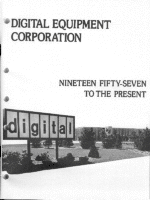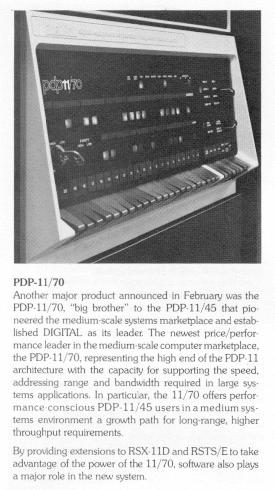 The following information is taken primarily from a DEC publication
entitled
Digital Equipment Corporation, Nineteen Fifty Seven to the Present,
published in 1978.
The following information is taken primarily from a DEC publication
entitled
Digital Equipment Corporation, Nineteen Fifty Seven to the Present,
published in 1978.
I am interested in rescuing and restoring older DEC equipment. You can read more about that here. |
| 1959 | First PDP-1 delivered in 1959. The last PDP-1 was built in 1969. The machine was an 18-bit computer capable of addressing up to 32K of core memory. A total of 53 machines were built. |
| 1961 | DECUS (Digital Equipment Users Society) founded |
| 1962 | First PDP-4 delivered. It was another 18-bit machine but slightly different architecture than the PDP-1. A total of 54 machines were built. |
| 1963 | First PDP-5 delivered. It was a 12-bit minicomputer. |
| 1964 | First PDP-6 was released late in the year. A total
of 23 of the 36-bit systems were installed.
The PDP-7, an 18-bit machine and the successor to the PDP-4. The PDP-7A was built about a year later. 120 PDP-7s were sold. |
| 1965 | First PDP-8 ("classic 8") was released. |
| 1966 | PDP-8/S ("serial") developed in nine months.
This was the first computer with 4K of memory that sold for less than $10,000.
PDP-9, an 18-bit computer, was released. It was about twice as fast as the PDP-7. Later in the year the PDP-9/L (a more compact PDP-9) was released and eventually 40 were sold. LINC-8 ("Laboratory Instrument Computer") was built, based on an earlier MIT Lincoln Labs design and a PDP-8 processor. |
| 1967 | PDP-10 announced as a replacement for the PDP-6. |
| 1968 | PDP-8/I (more expandable than the PDP-8/S) and PDP-8/L (smaller OEM version) released. |
| 1969 | PDP-12 released as a successor to the LINC-8.
PDP-15 announced as a replacement for the PDP-9 and PDP-9/L. It offered a separate processor dedicated to I/O. More than 400 of these 18-bit machines were ordered in the first 8 months. PDP-14 delivered in March, targeted primarily for the relay-logic market. |
| 1970 |
PDP-8/E
announced as a replacement for the PDP-8/I. It included
an OMNIBUS synchronous bus.
The first in a long line of PDP-11 machines was announced, the PDP-11/20. It was a 16-bit UNIBUS machine. PDP-14/L released as a lower cost machine with reduced I/O capability. |
| 1971 |
PDP-8/M announced as an OEM version of the PDP-8/E with only
one OMNIBUS mounting block.
PDP-11/15 released in the second quarter. PDP-11/05 released for the OEM market. PDP-11/45 released, containing core, metallic-oxide semiconductor and bipolar semiconductor memory technologies. Could hold as much as 128K and could run RSTS/E, RSX-11D and a FORTRAN system. |
| 1972 |
PDP-8/F introduced in March as an end user replacement for the PDP-8/M.
PDP-16/M announced for customers who needed a low-end machine. Used PROM (programmable read-only memory) and various options to provide a dedicated system. |
| 1973 |
PDP-11/10 released as an end user version of the PDP-11/20.
It included a four-level interrupt structure and multiple accumulators.
PDP-11/40 released with about twice the power of the PDP-11/20. A floating point package was offered as an option. |
| 1974 |
PDP-14/30 and PDP-14/35 released as programmable controllers.
A new VT14 programming terminal could be used to program them.
PDP-8/A released in May in two forms, an 8/A Module Kit and an 8/A OEM Kit. RT-11 introduced for a single user. It ran on any available PDP-11 with at least 8K of memory. RSX-11M introduced as a subset of RSX-11D. EDUSYSTEMS-100, 200 and 250 introduced. These packaged systems were BASIC language, core memory based designed for 1 to 8 users. |
| 1975 |
PDP-8/A-200 released, including a PDP-8/A with 4K semiconductor RAM,
an operator console and a 12-slot OMNIBUS. A one-hour memory
refresh battery backup was also included.
PDP-8/A-400 released, which was a PDP-8/A-200 but with two
core memory boards. The machine could be expanded up to 32K memory.
PDP-11/04 released in December for the OEM market. It is the third generation PDP-11 but remains completely program compatible with the PDP-11/05.
LSI-11 announced in February as a complete computing system (CPU, Memory and I/O) on a single printed circuit board. PDP-11/03 introduced as a packaged version of the LSI-11. RX01 dual floppy disc drive introduced in May. Each floppy could hold up to 256 KB in an IBM-compatible format. RP04 disc drive introduced for the PDP-11/35, 11/40, 11/45 and 11/50 as well as DECsystem-10 computers. It could hold 88 MB (formatted) and a transfer rate of 1.25 microseconds per byte. LA36 DECwriter II introduced. VT50 DECSCOPE released in September VT50 DECSCOPE released in September. It ran up to 9600 baud and was microprocessor-controlled. DECNET introduced in April. |
| 1976 |
PDP-8/A-800 series introduced as a high performance FORTRAN platform with
extended precision floating point capability.
PDP-11V03 released as a roll-around RT-11 platform based on the LSI-11. PDP-11T55 announced in December as a high performance disk-based system. The 11T55 was a redesigned 11/45 processor, 32K bipolar memory (with parity) and a FP11-C floating point processor. PDP-8/A-600 series introduced as a replacement for the PDP-8/E, PDP-8/F and PDP-8/M machines. PDP-11/34 introduced as a system, including an 11/34 processor with 32K memory, a dual drive RK11/RK05 and an LA36 printing terminal. RP05 introduced as a 100 MB disc drive. RP06 introduced as a 200 MB disc drive. RK05J introduced as a more reliable RK05. RK05F introduced as a non-removable version of the RK05J with twice the track density. It provided 6.64 MB on a PDP-8 and a 5 MB capacity on the PDP-11. VT52 terminal introduced as an enhanced VT50.
|
| 1977 |
PDP-11/34A introduced an an improved PDP-11/34.
PDP-11S55 introduced as a PDP-11/55 processor with 32K byte core, an FP11-C floating point processor, an RK611 (14 MB disk cartridge drive), RK06. RK06 introduced as as 14MB disc cartridge drive, midway between the RK05 and the RP series drives. PRS01 Paper Tape Reader for the LA36 introduced, using a 20mA current loop interface. PDP-11/60 introduced in March as a UNIBUS machine with cache memory. DECstation introduced as a computer based on the VT78 Video Data Processor, essentially a PDP-8. |
